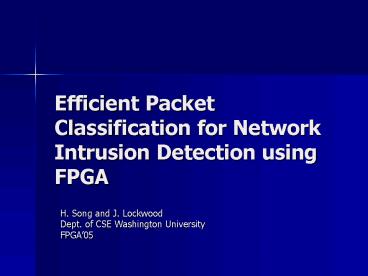Efficient Packet Classification for Network Intrusion Detection using FPGA - PowerPoint PPT Presentation
1 / 21
Title:
Efficient Packet Classification for Network Intrusion Detection using FPGA
Description:
Source IP address (external network) - any (internal network) ... combined values of these fields is much less than the total number of rules ... – PowerPoint PPT presentation
Number of Views:133
Avg rating:3.0/5.0
Title: Efficient Packet Classification for Network Intrusion Detection using FPGA
1
Efficient Packet Classification for Network
Intrusion Detection using FPGA
- H. Song and J. Lockwood
- Dept. of CSE Washington University
- FPGA05
2
Introduction
- NIDS that protect high-speed computer networks
demand - high throughput
- flexibility to handle new threats
- These systems classify Internet packets based on
- the header fields
- the strings in the packet content or traffic flow
3
Introduction (cont.)
- Packet header classification is an integrated
part of a full featured NIDS - rules usually contain 5-tuple header filters
- source IP address
- source port
- destination IP address
- destination port
- Protocol
- plus some strings (aka signature)
4
Introduction (cont.)
- Packet header fields are constant in length and
appear at fixed location in the packet - Signatures are variable-length and can be located
at any offset in the packet
5
Introduction (cont.)
- Due to the different nature of strings and packet
header fields, it is desirable to separate the
header classification process from the string
matching process - A cross-product of the two results can be used
to determine a complete rule match
6
Snort NIDS
- Within Snort, the incoming packet header
- compares against the header filters sequentially
- and then the packet payload compares against the
signatures in the context sequentially - This sw based system cannot keep up with high
speed networks - the system drops packets when the input traffic
load exceeds the processing power of the CPU
7
Hardware NIDS
- Packet header classification and content scanning
can be performed in parallel - improves the overall throughput
8
Problem Statement
- There are k relevant packets header fields
- H1, H2, , Hk
- Each field is a bit string and allows one of
three kinds of matches - exact
- prefix
- range
- The header rule set contains a sequence of N
rules - R1, R2, , RN
9
Problem Statement
- Each rule is a combination of k header fields
- A rule is said to match a packet if each field in
the rule matches the corresponding field in the
packet header in the specified way - A header match is not enough to identify a
malicious packet, further inspection needs to be
conducted
10
A Snort rule example
11
The Idea
- Many rules may share a common snort header rule
- Classify the packet based on the header first
- Then use this information to guide further
inspections of the packet content
12
BV-TCAM Architecture
- The design combines and optimizes the TCAM and
Bit-Vector algorithms for packet header
classification in NIDS - Like the BV output, the TCAM output forms another
bit vector and each bit in the vector indicates
the match to the corresponding rule field(s) or
not
13
Architecture (cont.)
- So the idea is
- the header fields are partitioned in a way that
some of them are classified using TCAM while the
others are classified using Bit Vector
algorithms
14
Architecture (cont.)
- TCAM example
15
Architecture (cont.)
- Bit-Vector algorithms are used for port
classification Build the port prefix lookup tree
for bit vector searching - each port's ranges are first transformed into a
series of prefixes - all prefixed are then inserted into a binary
decision tree - the branch decision at each level is decided by
the bit patter in the prefix - each valid prefix node has a bit vector created
- the bit vector indicates all the rules with its
port definition matching to this prefix
16
Architecture (cont.)
- Bit-Vector example
17
Architecture (cont.)
- After getting all three bit vectors from the TCAM
and the two longest prefix lookup trees, the set
of matches can be determined by intersecting
these bit vectors
18
Implementation
- A full FPGA-based NIDS is under development
- Based on the Snort rule set
- Prototype Xilinx XCV-2000E FPGA
- Source IP address (external network) -gt any
(internal network) - 33 distinct values (files headers)
- 33 x 72bits TCAM
- this size of TCAM can be implemented using an
embedded core on the FPGA
19
Implementation
- TCAM core is comprised of multiple block of
SRL16Es linked by carry-chains
20
Results
- Using the TCAM as a component avoids the need to
expand the size of the rule set by only using
TCAM to classify the fields that is represented
as prefix or exact value - Compressed number of entries needed in TCAM to
classify due to the fact that the number of
distinct combined values of these fields is much
less than the total number of rules
21
Results (cont.)
- Through the parallel operation and data structure
size compression, the architecture is optimized
for both throughput and storage efficiency - Resource consumption for TCAM is only 3 of the
available SRL16Es

